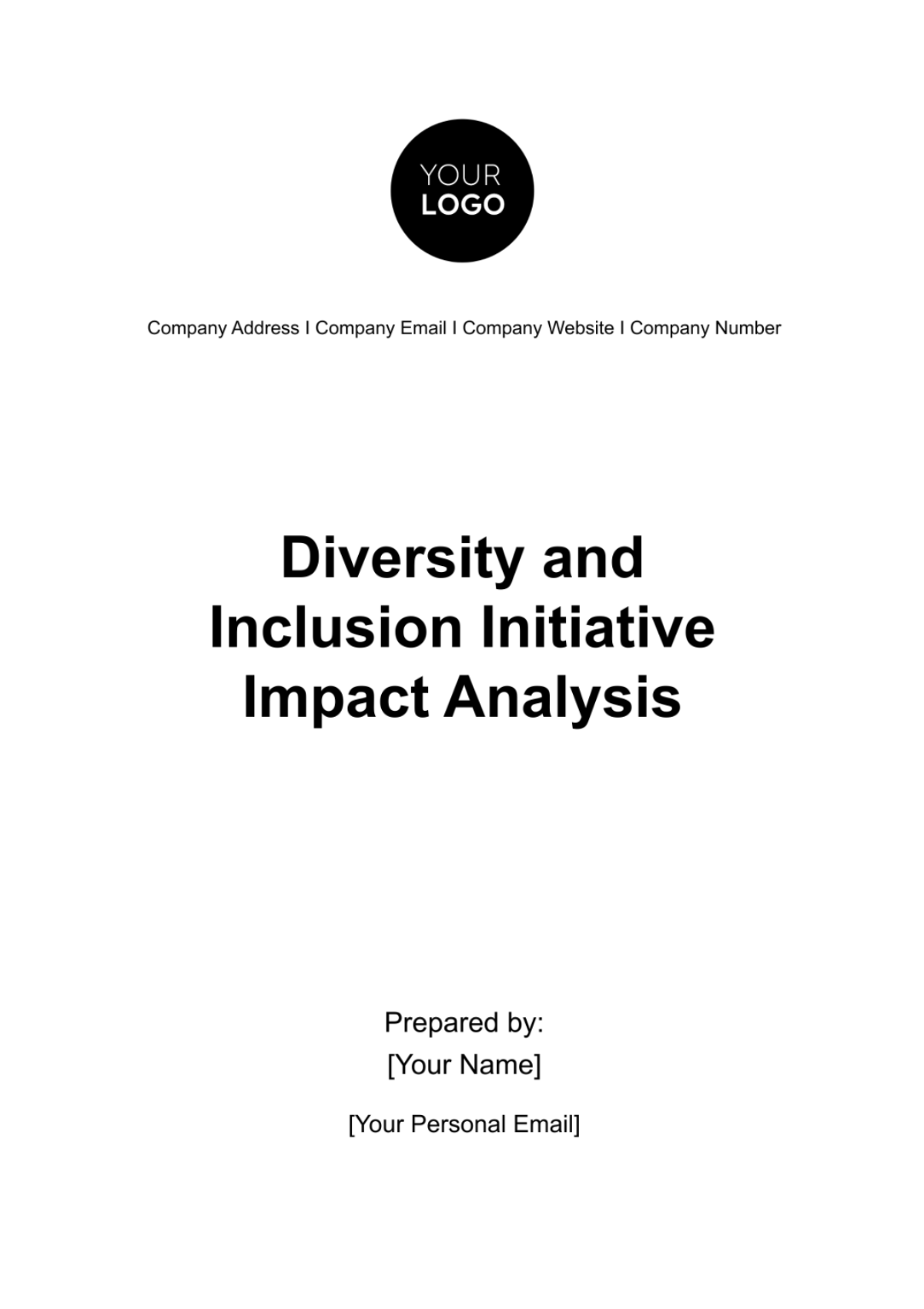Diversity and Inclusion Initiative
Impact Analysis
Purpose
The purpose of the Diversity and Inclusion Initiative Impact Analysis is to comprehensively evaluate the effectiveness of our diversity and inclusion programs. This analysis aims to measure the impact of these initiatives on our organization's culture, employee engagement, and overall performance. It will inform future strategies and initiatives to ensure a more inclusive and diverse workplace.
Background
At [Your Company Name], we have a long-standing commitment to diversity and inclusion. Our organization has implemented a range of initiatives over the years, including diversity training, mentorship programs, and policies promoting equal opportunities. This analysis seeks to provide insights into how these initiatives have influenced our workforce and organizational culture.
Objectives
The primary objectives of the Diversity and Inclusion Initiative Impact Analysis are as follows:
To assess the effectiveness of our diversity and inclusion initiatives.
To identify areas of strength and areas in need of improvement.
To provide actionable recommendations for enhancing diversity and inclusion efforts.
To align our strategies with HR legal guidelines and industry best practices.
Metrics
In this analysis, we will utilize the following metrics and KPIs to measure the impact of diversity and inclusion initiatives:
Diversity Representation
Employee Satisfaction
Retention Rates
Promotion Rates
Engagement Scores
Data Collection
Data Sources
We will gather data from diverse sources to ensure a well-rounded analysis. These sources include:
Demographic Data | Employee records and HR databases for information on gender, race, age, and other relevant demographics. |
Surveys | Employee satisfaction surveys, engagement surveys, and feedback forms. |
Feedback Mechanisms | Anonymous feedback channels, such as suggestion boxes or online platforms. |
Performance Metrics | Existing performance data, including promotion rates, retention rates, and diversity representation statistics. |
Data Privacy and Compliance
[Your Company Name] is committed to upholding the highest standards of data privacy and compliance with all relevant HR legal guidelines and privacy regulations, including but not limited to the Equal Employment Opportunity Commission (EEOC) guidelines and the General Data Protection Regulation (GDPR). All data collection and handling processes will prioritize employee privacy and confidentiality.
Analysis of Diversity Metrics
The following pie chart provides a visual representation of the gender distribution within [Your Company Name]. This data reflects the diversity of our workforce with respect to gender.
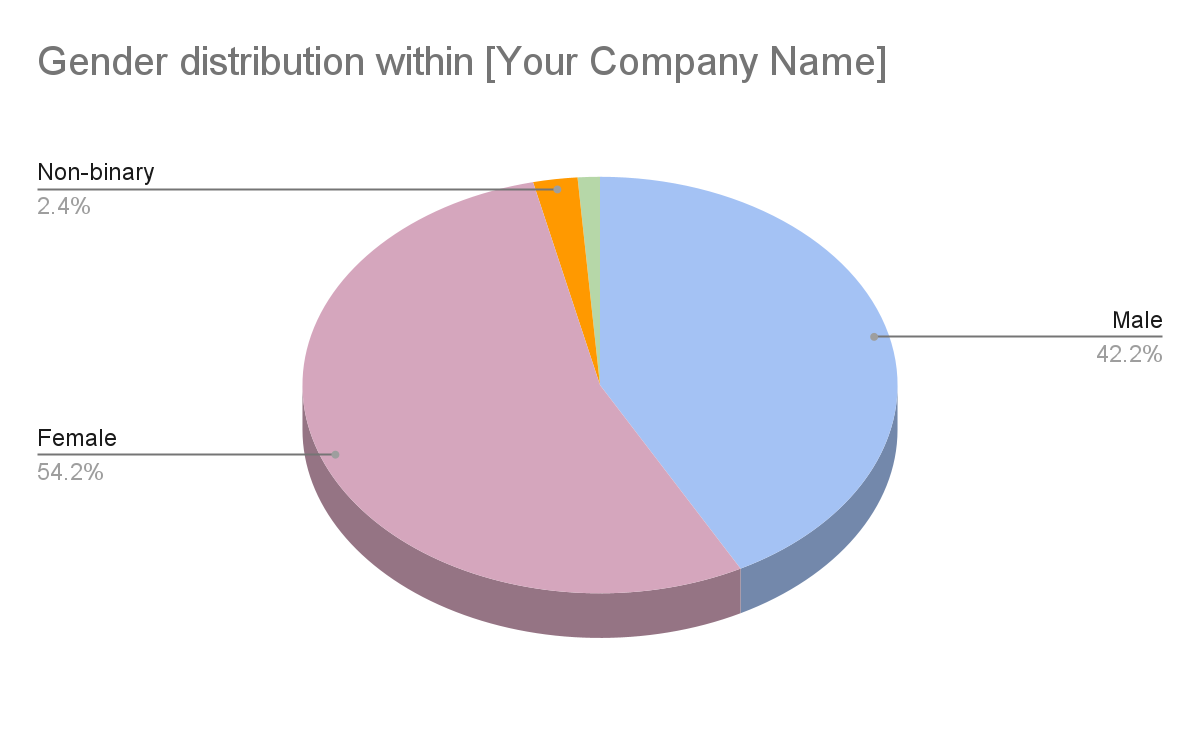
Assessment of Inclusion Metrics
In this section, we will delve into key inclusion metrics that are essential for gauging the effectiveness of our diversity and inclusion initiatives. We will analyze these metrics to ensure that our employees feel valued, included, and have equitable opportunities for growth and advancement.
Retention Rates
Examining employee retention rates among diverse groups is vital to understanding their sense of inclusion and commitment to our organization. We will:
Analyze retention rates by demographic categories, including gender, race, and age.
Identify any disparities in retention rates and assess potential contributing factors.
Develop strategies to address any retention challenges faced by underrepresented groups.
Promotion Rates
Our analysis will also include an assessment of promotion rates for employees from diverse backgrounds. We will:
Examine promotion rates by demographic groups to determine if opportunities for advancement are equitable.
Identify any barriers that may be hindering diverse employees' career progression.
Implement targeted initiatives to ensure fair and inclusive promotion practices.
Engagement Scores
Employee engagement plays a pivotal role in our workplace culture. We will evaluate employee engagement scores, with a focus on diversity and inclusion-related aspects. We will:
Review employee engagement survey data, specifically assessing responses related to diversity and inclusion.
Identify trends in engagement scores and areas where improvement is needed.
Develop strategies to enhance engagement and create an inclusive work environment that fosters employee commitment and satisfaction.
Employee Satisfaction
The following bar chart provides a visual representation of employee satisfaction levels regarding our diversity and inclusion initiatives at [Your Company Name]. This data reflects responses from recent employee satisfaction surveys conducted within our organization.
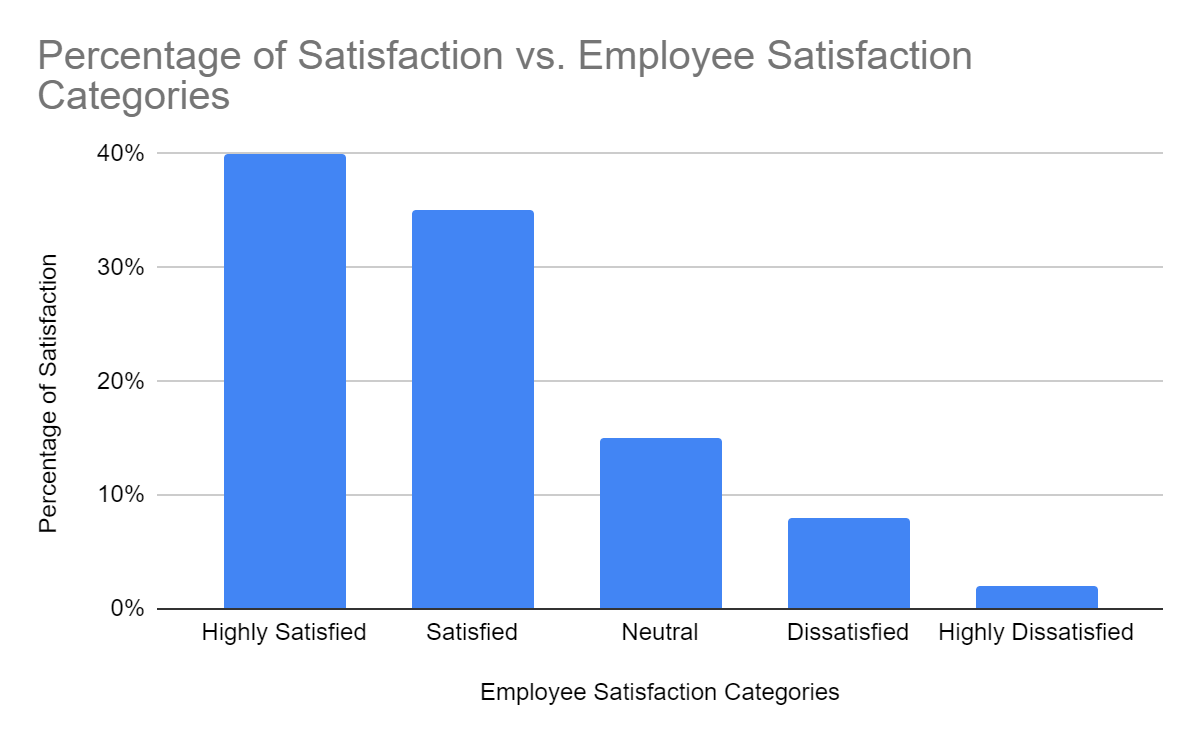
Qualitative Feedback
Employee Surveys
To gather qualitative feedback on diversity and inclusion experiences, we employ a structured process of conducting employee surveys. Our approach includes:
Designing surveys with questions that encourage employees to share their thoughts, experiences, and suggestions related to diversity and inclusion.
Administering surveys electronically to ensure anonymity and ease of participation.
Encouraging open and honest responses, emphasizing the importance of candid feedback.
Analyzing survey responses to identify recurring themes and sentiments, which inform our diversity and inclusion strategies.
Interviews and Focus Groups
In addition to surveys, we conduct interviews and focus groups to gain deeper insights into employees' perceptions. These sessions involve:
Selecting diverse employee representatives to participate in one-on-one interviews or focus groups.
Creating a safe and inclusive environment where participants can openly express their experiences and viewpoints.
Capturing qualitative data, which is then analyzed to uncover nuanced insights that shape our diversity and inclusion initiatives further.
Comparative Analysis
The chart below presents a comparative analysis of employee satisfaction with diversity and inclusion efforts at [Your Company Name] over a three-year period. The data reflects the evolution of employee sentiment with respect to our diversity and inclusion initiatives, providing valuable insights into the impact of our ongoing efforts.
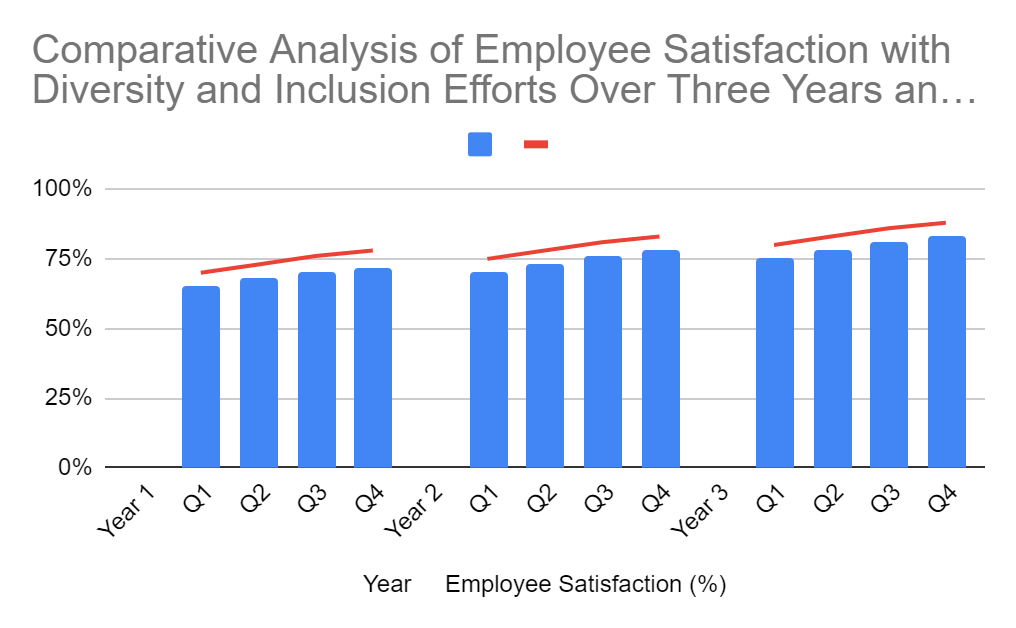
Identifying Successes and Challenges
Successes
Our journey toward a more inclusive workplace has yielded notable successes. Notably, we've seen an increase in the representation of underrepresented groups at various levels of our organization. Additionally, our employee engagement scores, particularly in areas related to diversity and inclusion, have shown consistent improvement. Employee feedback reflects a growing sense of belonging and appreciation for our diversity initiatives, demonstrating that our commitment to fostering an inclusive culture is making a positive impact.
Challenges
However, we also acknowledge that challenges persist. Retention rates for certain underrepresented groups still require attention, and we are actively addressing barriers to their career advancement. Our ongoing commitment includes addressing unconscious biases and ensuring equitable access to opportunities. We are steadfast in our dedication to continuously evolving our strategies to overcome these challenges and further enhance our diversity and inclusion efforts.
Business Impact
Diversity and inclusion drive our organization's success. Research shows a clear link between diversity commitment and improved finances. Diverse perspectives fuel innovation, resulting in products that resonate with a broader customer base. This boosts satisfaction and strengthens client relations. Our inclusive culture also sparks creativity, tapping into our workforce's full potential. Together, diversity and inclusion are vital drivers of our financial success, customer loyalty, and innovation.
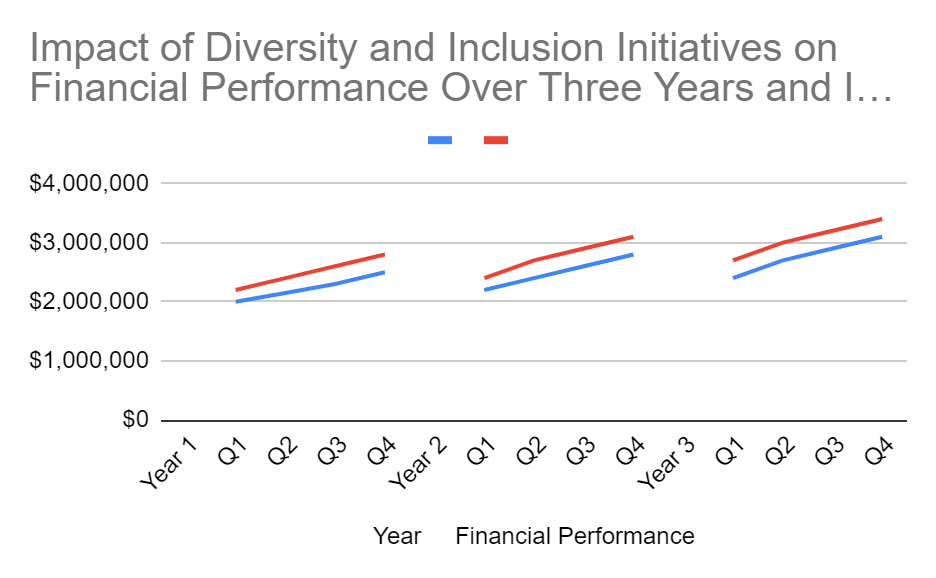
Recommendations
In our ongoing commitment to fostering an inclusive workplace, we present a set of actionable recommendations aimed at further enhancing the effectiveness of our diversity and inclusion initiatives. These recommendations are the culmination of our comprehensive analysis and reflect our dedication to continually improving our efforts.
Implement ongoing diversity training programs for all employees to increase awareness and understanding of diversity issues.
Revise recruitment practices to attract a more diverse talent pool through targeted outreach and inclusive language in job postings.
Expand mentorship programs to provide career support for underrepresented employees.
Offer leadership development programs to prepare diverse talent for higher roles.
Continue tracking diversity metrics and regularly review progress to adapt strategies accordingly.
Reporting
The findings and recommendations will be presented to senior leadership and stakeholders through a detailed report and an interactive presentation. This approach facilitates informed discussions, enabling leaders to understand and endorse strategies for improving diversity and inclusion.
Transparency ensures open access to data and methodologies, while accountability drives the implementation of recommendations. These principles guide our commitment to a diverse and inclusive workplace, promoting fairness and continual progress in our diversity initiatives.
Conclusion
We extend our sincere gratitude to all employees who actively participated in the diversity and inclusion analysis process. Your valuable insights, feedback, and contributions have been instrumental in shaping this analysis and its outcomes. Your dedication to fostering a more inclusive workplace is a testament to our shared commitment to diversity and inclusion, and we are deeply appreciative of your involvement in this critical endeavor. Together, we continue to move forward on our journey toward a more diverse, inclusive, and equitable workplace.
HR Templates @ Template.net
